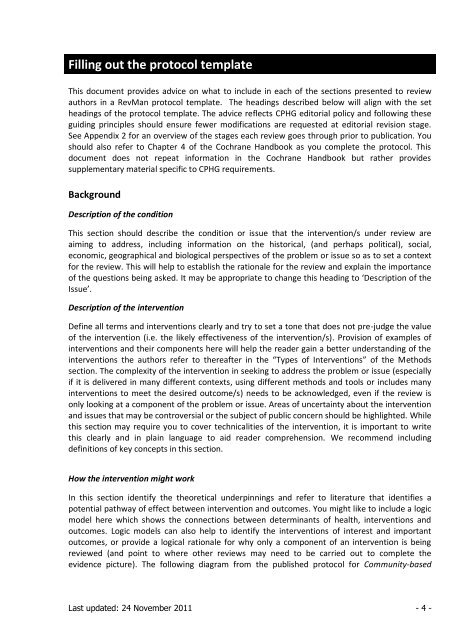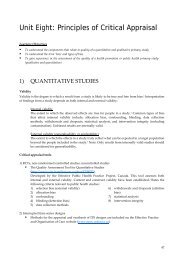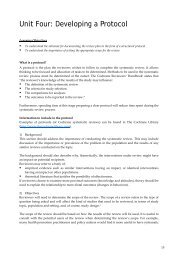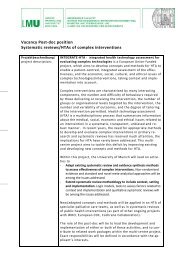Guide for Developing a Cochrane Protocol - Cochrane Public Health ...
Guide for Developing a Cochrane Protocol - Cochrane Public Health ...
Guide for Developing a Cochrane Protocol - Cochrane Public Health ...
Create successful ePaper yourself
Turn your PDF publications into a flip-book with our unique Google optimized e-Paper software.
Filling out the protocol template<br />
This document provides advice on what to include in each of the sections presented to review<br />
authors in a RevMan protocol template. The headings described below will align with the set<br />
headings of the protocol template. The advice reflects CPHG editorial policy and following these<br />
guiding principles should ensure fewer modifications are requested at editorial revision stage.<br />
See Appendix 2 <strong>for</strong> an overview of the stages each review goes through prior to publication. You<br />
should also refer to Chapter 4 of the <strong>Cochrane</strong> Handbook as you complete the protocol. This<br />
document does not repeat in<strong>for</strong>mation in the <strong>Cochrane</strong> Handbook but rather provides<br />
supplementary material specific to CPHG requirements.<br />
Background<br />
Description of the condition<br />
This section should describe the condition or issue that the intervention/s under review are<br />
aiming to address, including in<strong>for</strong>mation on the historical, (and perhaps political), social,<br />
economic, geographical and biological perspectives of the problem or issue so as to set a context<br />
<strong>for</strong> the review. This will help to establish the rationale <strong>for</strong> the review and explain the importance<br />
of the questions being asked. It may be appropriate to change this heading to ‘Description of the<br />
Issue’.<br />
Description of the intervention<br />
Define all terms and interventions clearly and try to set a tone that does not pre-judge the value<br />
of the intervention (i.e. the likely effectiveness of the intervention/s). Provision of examples of<br />
interventions and their components here will help the reader gain a better understanding of the<br />
interventions the authors refer to thereafter in the “Types of Interventions” of the Methods<br />
section. The complexity of the intervention in seeking to address the problem or issue (especially<br />
if it is delivered in many different contexts, using different methods and tools or includes many<br />
interventions to meet the desired outcome/s) needs to be acknowledged, even if the review is<br />
only looking at a component of the problem or issue. Areas of uncertainty about the intervention<br />
and issues that may be controversial or the subject of public concern should be highlighted. While<br />
this section may require you to cover technicalities of the intervention, it is important to write<br />
this clearly and in plain language to aid reader comprehension. We recommend including<br />
definitions of key concepts in this section.<br />
How the intervention might work<br />
In this section identify the theoretical underpinnings and refer to literature that identifies a<br />
potential pathway of effect between intervention and outcomes. You might like to include a logic<br />
model here which shows the connections between determinants of health, interventions and<br />
outcomes. Logic models can also help to identify the interventions of interest and important<br />
outcomes, or provide a logical rationale <strong>for</strong> why only a component of an intervention is being<br />
reviewed (and point to where other reviews may need to be carried out to complete the<br />
evidence picture). The following diagram from the published protocol <strong>for</strong> Community-based<br />
Last updated: 24 November 2011 - 4 -








